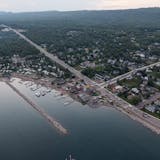Interested neighbors and "This Old House" enthusiasts stepped gingerly over broken glass from shattered windows and lights. They peered at holes punched in walls and radiators ripped from the floor.
Many who toured the six vacant properties slated for demolition in St. Paul's historic Dayton's Bluff neighborhood said that even with a $1 asking price and a potential $150,000 subsidy from the city, too much work and money would be needed to turn the homes around. But the crowd of hundreds also included developers such as Rob Shaffner and Dennis Kuchenmeister, who looked past ripped carpeting, cracked linoleum and peeling paint hanging from the ceiling in strips. They saw the location, interesting old cabinetry and — at least in one case — potential.
That's what neighbors, preservationists and St. Paul staff members were hoping when they organized Sunday's tour, a last-ditch effort to market the city-owned sites that will be torn down if no one steps forward to rehabilitate them.
Development proposals for four of the Dayton's Bluff properties, which are residential, must be submitted by May 11. The deadline for two commercial buildings on Bates Avenue is June 8.
For nearby residents, the prospect of six demolitions within a seven-block area is worrisome.
"It could have a really dramatic and negative impact on the community to have all of these holes," said Carol Carey, who lives in Dayton's Bluff and is the executive director of the nonprofit Historic St. Paul. "You can either send a message that this housing stock is too far gone and worthy of demolition and the creation of vacant lots, or you can send a message that this neighborhood is worthy of investing in."
The city tried to market the six sites, instead of demolishing them one by one, because they are in the historic district, said Jonathan Sage-Martinson, St. Paul's planning and economic development director. But after several unsuccessful efforts, officials decided to tear them down. When neighbors caught wind of that, they pushed the city to try once more to find people interested in developing the sites.
Neighborhood impact
Residents and city staffers organized Sunday's home tour — a tool the local district council used often during the recession to market properties. They are also spreading the word on social media, former district council president Elizabeth Matakis said.


